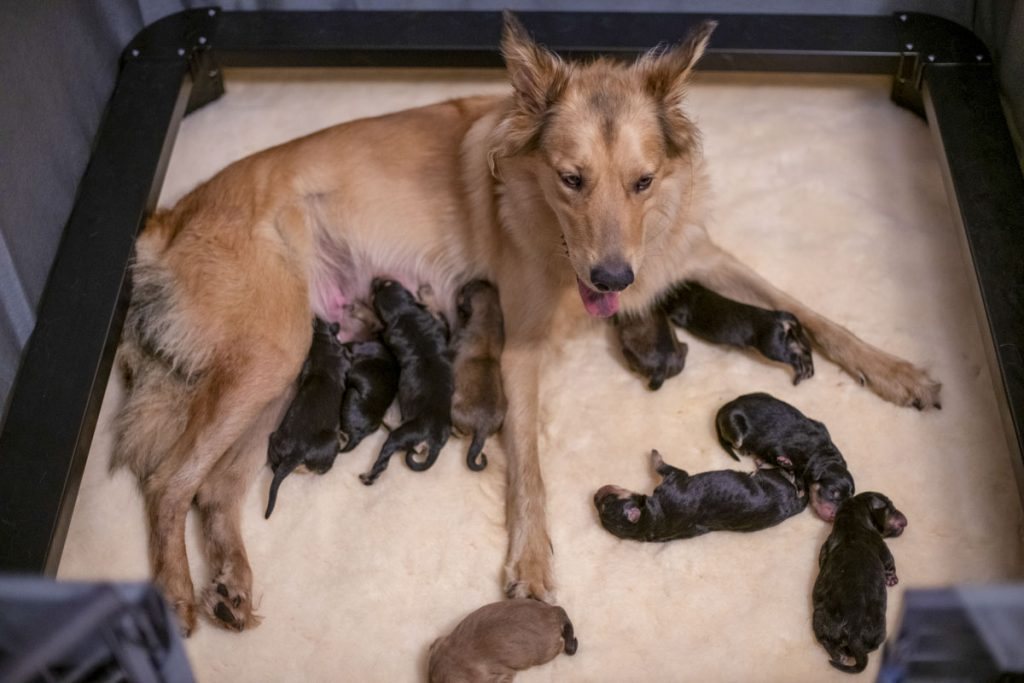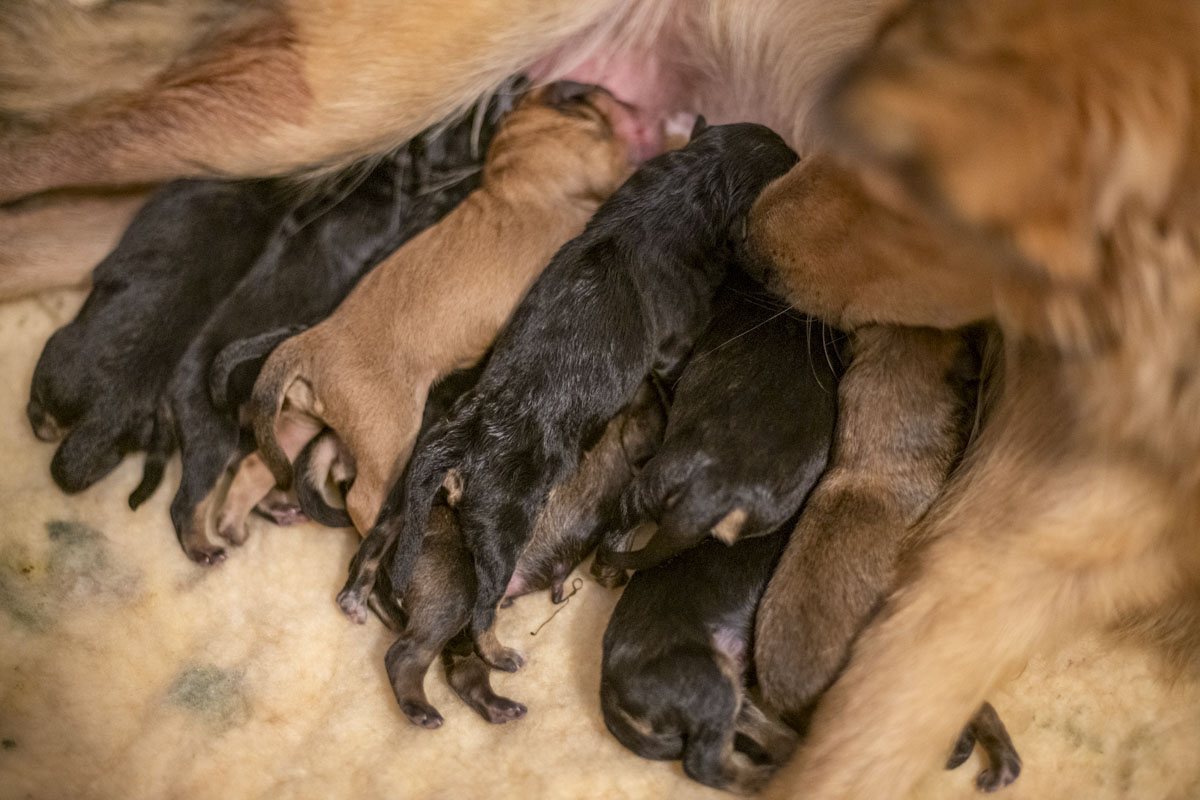When Josie started digging at the vet fleece in her whelping box, I had a feeling that it was time. It was the morning of September twenty-eighth. We were a few days early by my calculation. As a first-time breeder, her being early made me nervous. On that same morning at 08:26, I logged that Josie had skipped breakfast. I took her temperature and logged it in my breeder’s journal as ninety-eight and one-tenth degrees Fahrenheit. In my preparations as a breeder, I had watched Myra Savant Harris’ seminar and read two of her books. I knew these were indicators that whelping was imminent.
At 16:49 we took a walk down by the creek. We were returning to the whelping room when at the top of the south deck’s staircase Josie suddenly paused. About a cup or two of clear, viscous fluid splattered to the deck. We returned to the whelping room, where I directed Josie to the whelping box. I went to the kitchen and returned at 16:56 with a bowl of vanilla ice cream. You may recall that when a dam goes into whelp, the three main substances her body uses for delivery are glucose, calcium, and oxytocin. Oxytocin, which is stored in the pituitary gland, starts the contractions, and regulates how often they occur. Calcium gives strength and intensity to the contractions. And glucose provides energy and endurance. So, as a readily available source of calcium and glucose, vanilla ice cream is commonly given during labor. At 17:21, Josie began to push and grunt. She circled the whelping box anxiously and occasionally looked at me. Her facial expressions alternated between a pleading, “what the heck is going on?” and an accusatory, “what on earth did you do to me?”

At 18:16, we had our first pup. And over the course of the next five hours Josie labored for nine more beautiful, healthy pups. I fed her a scoop or so of vanilla ice cream in between each one. Watching each of those pups come into the world and begin to breath independently was simultaneously a terrifying, miraculous experience I will never forget. The pups varied in size from thirteen ounces to seventeen-and-one-half ounces. But most of them were right around one pound at birth. I later learned that Josie had whelped a few days early because the pups had fully developed ahead of schedule and were ready to come out. They were big pups. I credit this to Josie’s fitness and to her diet. I had consulted with Purina nutritionists prior to Josie’s pregnancy. I followed their prescriptive guidance, prenatally feeding her Purina Pro Plan Puppy formula for weeks prior to her projected whelp date. By the time she came to whelp, she was consuming about one-hundred and fifty percent of her normal daily intake. You may recall that that fitness and nutrition play a critical role in a healthy mother giving birth to and nursing a litter of healthy pups. As you know, nursing pups is incredibly taxing on a dam. And the nutrition being consumed by pups at this critical period is critically important. A significant portion of our preparation and study for this litter revolved around nutrition.
At this point, I feel compelled to mention one of the most incredible things I have ever seen. I struggle to even describe the scene. As Josie was dutifully laboring in her whelping box for five-to-six hours, one-by-one the pups who had just been born began to nurse on her. While she was putting everything she had into pushing out pups one after another, at the same time there were three, then four, then eight and nine pups literally hanging on her every move. In their fight for survival, the neonates were voracious and ruthlessly demanding on their mother. At one point, Josie was cleaning pups, nursing pups, and whelping pups all at the same time! Her fortitude, endurance, and determination left me both astounded and speechless.

For the next seventy-two hours, Josie and I slept little to naught. About three times over that seventy-two-hour time span I heard a pup’s muffled cry. Even though Josie’s whelping box was equipped with pig rails, sometimes a pup gets in bad way. In danger of suffocation. That muffled sound of a helpless little pup was enough to keep me awake for about three days. I was not about to let that happen on my watch. Not if I could help it. But my primary job for the first few weeks was to constantly shovel food at Josie. She was fed all the Purina Pro Plan Puppy formula she could eat. About three hundred percent of her normal diet. Her kibble meals were always soaked in Goat’s Milk Esbilac. About twice per day she also received a half-can of Purina Pro Plan canned food covered in mother’s pudding. Our mother’s pudding was made with cook-and-serve vanilla pudding, raw natural sugar, and Goat’s Milk Esbilac. These two meals were also covered with a heaping teaspoon of fenugreek. Fenugreek facilitates the production of milk in nursing mammals. The fenugreek topping was continued until the whelping room reeked of its unique and easily identifiable odor.
On their third day, Josie’s pups began to receive a few seconds of Early Neurological Stimulation. Once per day, each pup was put through five brief handling exercises. These specific exercises continued through day sixteen. The handling of each pup once per day involved the following exercises performed in specific order: tactical stimulation between toes, head held erect, head pointed down, supine position, and thermal stimulation. These five exercises will produce neurological stimulations, none of which naturally occur during this early period of life. Five benefits have been observed in canines that were exposed to these stimulation exercises. The benefits noted were improved cardiovascular performance (heart rate), stronger heart beats, stronger adrenal glands, more tolerance to stress, and greater resistance to disease.

Early Neurological Stimulation is an early component of the Puppy Culture program. Puppy Culture is a complete program of over fifty lessons from whelping box to new home that is scientifically proven to greatly improve outcomes for puppies. In the next installment of this series, I will go into greater depth about the goals of my breeding program and the application of the Puppy Culture methodology for raising English shepherd puppies. I will also complain about doing more laundry than I had ever imagined.


2 thoughts on “Puppies & Laundry Part 1”
Comments are closed.